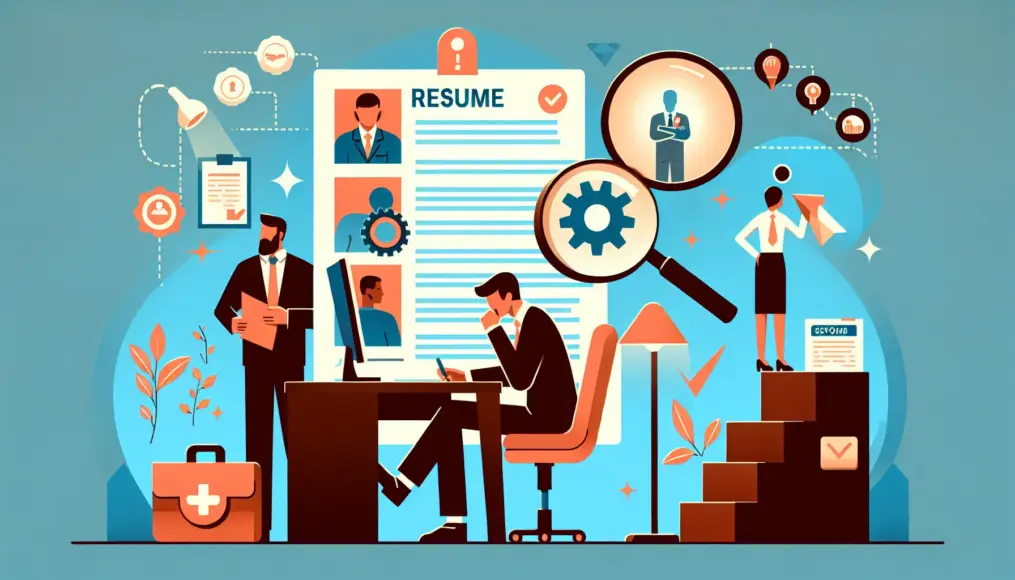If you’re aiming for a mid-career position, creating an impactful self-PR (self-promotion) is crucial. This is your chance to highlight your strengths and leave a lasting impression on the interviewer within a limited timeframe. In this article, we’ll delve into how to effectively write your self-PR, so you can take inspiration and get started.
Self-PR is more than just a simple introduction; it’s a vital tool for organizing your experiences and skills and conveying them accurately to meet the employer’s needs. To succeed, it’s essential to engage in thorough self-analysis, clearly demonstrating your strengths and achievements.
We’ll cover specific methods for writing your self-PR, share successful examples, and point out common pitfalls to avoid. By the time you finish reading, you’ll be well-equipped to create a self-PR that truly stands out.
- Understand the importance of self-PR and the skills sought in mid-career hiring
- Learn how to write an effective self-PR with a successful structure
- Master the art of telling compelling stories that resonate with interviewers
Understanding the Importance of Self-Promotion
When it comes to successfully navigating the mid-career job market, mastering the art of self-promotion is essential. In a sea of applicants, effectively conveying your skills and experiences is key to standing out. In this section, we’ll delve into why self-promotion is so important and what skills are typically sought after in mid-career hiring.
Self-promotion is a crucial opportunity to make a lasting impression on interviewers. By organizing and articulating your strengths and past experiences, you can communicate your value clearly. Furthermore, understanding the skills that employers are looking for and tailoring your self-promotion accordingly can lead to better outcomes in the hiring process.
Why Is Self-Promotion Important?
Self-promotion goes beyond merely introducing yourself; it’s a vital tool for communicating your strengths and value to others. This is especially true in mid-career hiring, where companies seek candidates who can hit the ground running. Therefore, it’s essential to showcase your abilities based on your previous experiences and achievements. A well-crafted self-promotion can leave a lasting impression on interviewers, putting you in a more favorable position during the selection process.
Additionally, through self-promotion, you can gain valuable insights into your own career. Reflecting on which experiences have helped you grow and identifying the skills you should emphasize will deepen your self-understanding. This preparation will enable you to express yourself with greater confidence during interviews.
- Self-promotion is a critical asset in mid-career hiring.
- It serves as a means to leave a strong impression on interviewers.
- It provides an opportunity for deeper self-understanding.
Skills in Demand for Mid-Career Positions
In mid-career hiring, companies often seek candidates who can immediately contribute, which means specific skills and experiences are frequently prioritized. While these can vary by industry and role, common skills sought after include communication skills, problem-solving abilities, and teamwork. These competencies are essential for ensuring smooth operations within a company.
Moreover, specialized knowledge and technical skills are also vital. Effectively showcasing the skills you’ve developed in your previous positions can demonstrate how you can contribute to a potential employer. This will make your self-promotion more compelling.
In addition to self-promotion, how you craft your resume is also a key factor in your success during the mid-career job search. Notably, the way you articulate your motivation for applying can be crucial in presenting yourself to a company. If you’re interested in learning more, check out our article on “The Key to Job Change Success! How to Write Your Motivational Statement in Your Resume” to discover effective ways to express your motivation.
- Mid-career hiring demands skills that demonstrate immediate value.
- Communication skills and teamwork are critical.
- Effectively showcasing specialized knowledge and technical skills can enhance your appeal.
How to Write an Effective Self-PR
When it comes to writing a self-promotion (self-PR), the first step is to have a solid understanding of yourself. By engaging in self-analysis, you can identify your strengths and unique traits, and think about how to effectively showcase them. In this section, we’ll delve into how to conduct self-analysis and outline the structure of a successful self-PR.
A self-PR should not just be a list of experiences; it should tell a story with a clear message you want to convey. By clearly defining your strengths and achievements and linking them to how you can contribute to a company, you can create a compelling self-PR.
Conducting Self-Analysis
Self-analysis is a great opportunity to reflect on your career and skills. Start by listing the experiences you’ve had and the skills you possess. Additionally, it’s important to sort through your past successes and failures to consider what you’ve learned and how you’ve grown from those experiences.
Feedback from others can also be invaluable for your self-analysis. By asking trusted friends or colleagues about your strengths and areas for improvement, you can gain an objective perspective. This might even help you discover new strengths you weren’t aware of.
- List your experiences and skills
- Organize your successes and failures
- Seek feedback from others
Structure of a Successful Self-PR
A successful self-PR typically follows a few key components. Begin with an “introduction,” then highlight your strengths by weaving in “specific achievements” or “anecdotes.” Finally, it’s effective to connect these strengths to how you can contribute to the company.
Using concrete examples allows you to convey a clear image rather than relying on abstract expressions. Incorporating numbers and results can make your self-PR even more persuasive.
For those who want to dive deeper into the points of self-analysis and self-PR mentioned in this article, I recommend checking out this article: “Key to Job Change Success! Effective Resume and Work History Writing Guide”. This guide offers practical advice on writing resumes and work histories, providing crucial information for a successful job search.
- Start with an introduction
- Include specific achievements or anecdotes
- Connect to contributions to the company
Success and Failure Examples of Self-Promotion
When crafting a self-promotion statement, referencing both successful and unsuccessful examples can be incredibly valuable. Successful self-promotions teach us how to effectively highlight our strengths, while learning from common pitfalls can help us create a more impactful statement. In this section, we’ll delve into key takeaways from successful examples and strategies to avoid failures.
Successful examples provide concrete tips for enhancing your self-promotion. By reflecting on real-life instances, you can better understand how to articulate your experiences and skills. Conversely, studying failure examples helps you steer clear of making the same mistakes.
Key Takeaways from Successful Examples
Many effective self-promotions incorporate specific achievements or anecdotes. For instance, one applicant shared their experience of increasing sales by 20% through a project at a previous job. By presenting concrete figures and results, they left a strong impression of their capabilities on the interviewer.
Additionally, quoting endorsements from others can be highly effective. By including praise from supervisors or colleagues, you can objectively reinforce your strengths. This approach adds credibility to your self-promotion.
- Incorporate specific achievements and anecdotes
- Use numbers to enhance your appeal
- Quote evaluations from others
Strategies to Avoid Common Pitfalls
When writing a self-promotion statement, it’s easy to fall into the trap of vague expressions or generic self-praise. For example, simply saying “I’m hardworking” doesn’t convey a clear image. It’s crucial to avoid such abstract language and instead provide concrete examples of your experiences.
Moreover, be mindful of making your self-promotion too lengthy. Interviewers see many candidates, so a concise and clear self-promotion is essential. Focus on the main points and ensure that the key information is communicated effectively.
- Avoid vague expressions
- Provide concrete examples in your explanation
- Aim for a concise and clear self-promotion
How to Craft Compelling Stories for Interviews
When it comes to self-promotion during interviews, incorporating specific anecdotes can be incredibly effective. By sharing stories that highlight your strengths and experiences, you can leave a lasting impression on your interviewers. In this section, we’ll delve into how to choose impactful stories and tips for conveying them effectively.
Anecdotes are crucial for making your self-presentation more concrete and easier for others to understand. The stories you select can significantly alter the impression you create. By choosing the right anecdotes and communicating them effectively, you can craft a persuasive self-presentation.
Choosing the Right Anecdotes
When selecting anecdotes, start by recalling memorable experiences from your past. It’s essential to consider not only your successes but also challenges you’ve overcome and lessons learned from failures. The key is to demonstrate how these experiences contributed to your personal growth.
Moreover, it’s even more effective if the anecdotes you choose relate to the company or position you’re applying for. By selecting stories that align with the skills and values sought by the employer, you can enhance the appeal of your self-presentation.
- Recall memorable experiences
- Consider both successes and challenges
- Choose anecdotes related to the company or position
Tips for Effectively Conveying Your Anecdotes
When sharing your anecdotes, it’s important to infuse them with a sense of storytelling. Specifically, focus on four key elements: “Situation,” “Challenge,” “Action,” and “Result.” Begin by describing the situation and explaining the challenges you faced. Then, clearly outline your actions and the results that followed, leaving a strong impression on your audience.
Additionally, speaking with passion is crucial. By conveying your feelings and thoughts about your experiences, you can communicate the significance of the story and your enthusiasm to your interviewers. Remember to relax and express yourself in your own words.
For those looking for more information on crafting anecdotes, I recommend checking out this article: “How to Write a Resume After Graduation! A Step-by-Step Guide to Success”. This guide provides valuable insights into resume writing and self-promotion techniques, equipping you with useful information to succeed in your job search.
- Incorporate storytelling (Situation, Challenge, Action, Result)
- Infuse your experiences with emotion and passion
- Relax and speak in your own words
Summary
When it comes to mid-career hiring, crafting a compelling self-promotion is a crucial tool for effectively communicating your strengths and experiences. To succeed, it’s essential to start with self-analysis, allowing you to understand your unique traits and achievements. By selecting specific episodes from your career and weaving them into a narrative, you can leave a lasting impression on interviewers. Additionally, learning from successful examples and steering clear of common pitfalls is key.
When writing your self-promotion, choose stories that resonate with your audience and convey your passion. By combining these elements, you can create a more engaging self-promotion that enhances your chances of getting hired.
- Understand your strengths through self-analysis
- Use specific anecdotes to create a narrative
- Reference successful examples and avoid common mistakes
Thank you for reading to the end! I hope you found this helpful in crafting your self-promotion. Feel free to share your thoughts in the comments!



Comment